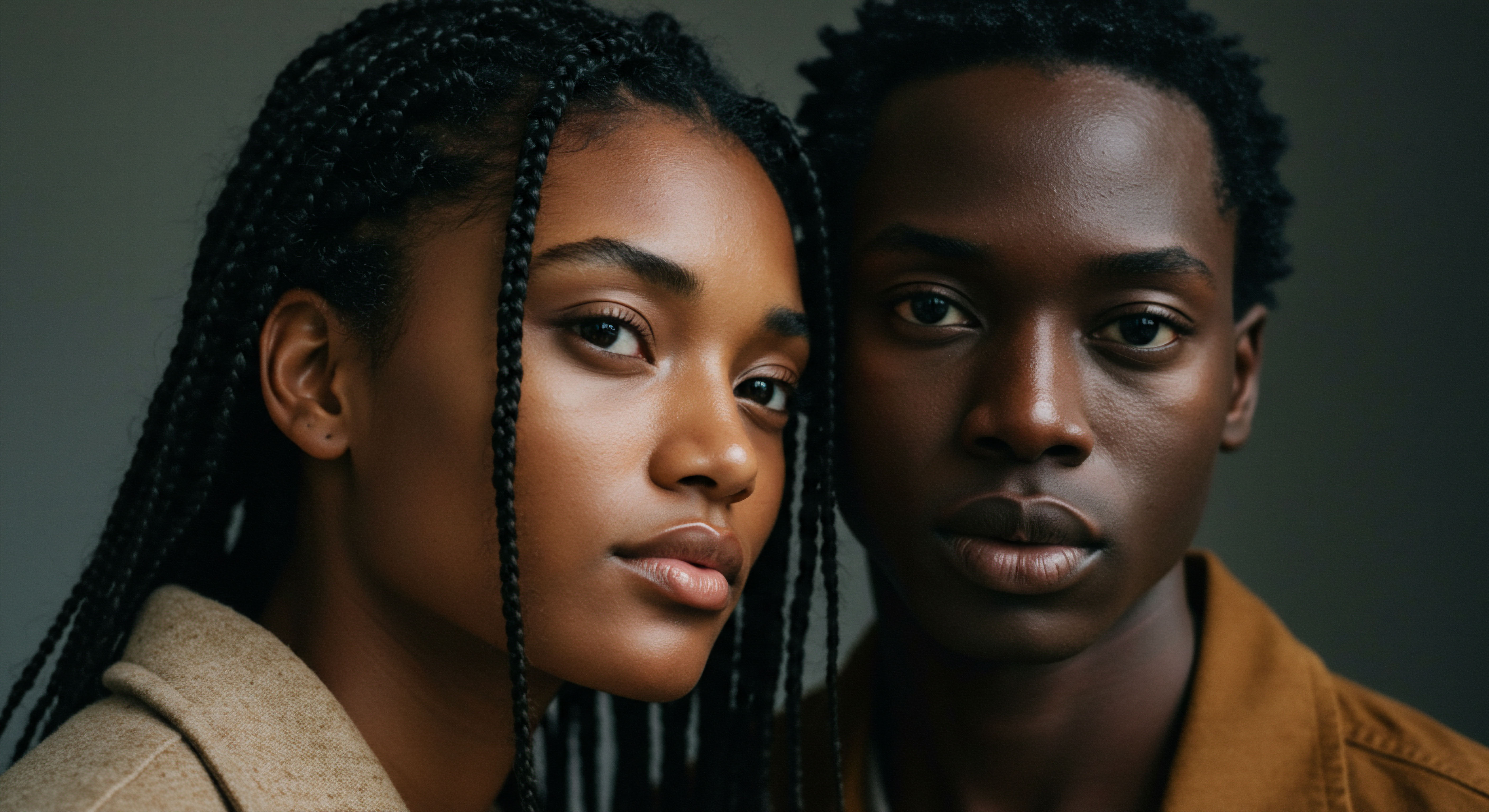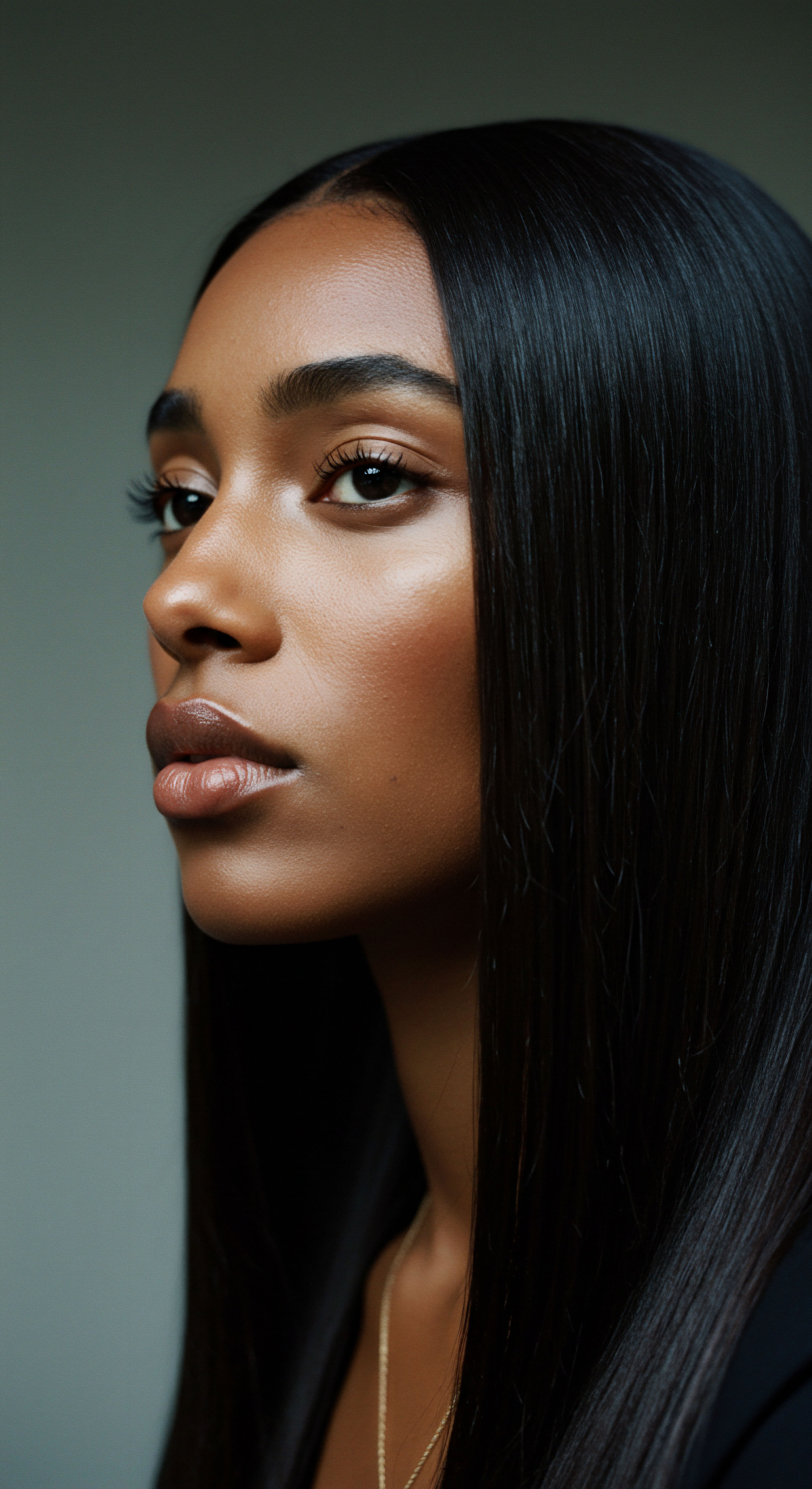
Roots
The quiet conversation our hair holds with the deepest parts of us often goes unheard, a subtle exchange between our inner rhythms and the vibrant strands that crown our heads. For generations, understanding hair has extended beyond mere aesthetics, reaching into realms of identity, wellness, and inherited wisdom. Today, as we stand at the threshold of scientific discovery, a familiar yet unexpected player steps onto this stage ❉ melatonin, a molecule so often associated with the hushed hours of night, now reveals its potential influence on the very cycle of hair growth, particularly across the rich spectrum of diverse hair textures.
Consider the fundamental architecture of hair, a marvel of biological engineering. Each strand springs from a tiny organ beneath the scalp, the Hair Follicle. This miniature factory undergoes a continuous, cyclical process of growth, regression, and rest.
This cycle is a testament to the body’s ceaseless renewal, a delicate balance orchestrated by a multitude of signals. Understanding these phases is paramount to appreciating any external influence, including that of melatonin.

The Hair Follicle’s Rhythmic Dance
The life of a single hair unfolds in distinct stages, a biological rhythm echoed across every hair type, from the most tightly coiled to the straightest strand.
- Anagen ❉ This is the growth phase, the period of active cellular division within the hair follicle. During this time, hair cells multiply rapidly, pushing the hair shaft outward. The duration of this phase varies significantly among individuals and hair types, often lasting several years. Longer anagen periods correlate with greater hair length potential.
- Catagen ❉ A brief, transitional phase, signaling the end of active growth. The hair follicle shrinks, and the hair shaft detaches from its blood supply. This stage typically lasts a few weeks.
- Telogen ❉ The resting phase, where the hair remains in the follicle but is no longer growing. Old hair sheds during this time, making way for new growth. This phase can span a few months before the cycle begins anew with a fresh anagen phase.
A harmonious balance between these phases is vital for maintaining hair density and overall scalp wellness. Disruptions to this equilibrium, whether due to stress, hormonal shifts, or environmental factors, can lead to concerns such as thinning or shedding.

Melatonin’s Presence Beyond Sleep
While melatonin is widely recognized for its role in regulating our sleep-wake patterns, its biological reach extends far beyond the pineal gland, the primary source of its production. This remarkable molecule is also synthesized in various peripheral tissues, including the skin and, indeed, the hair follicles themselves. This local production suggests a more intimate connection with dermal processes than previously understood.
Melatonin, a molecule known for its role in regulating sleep, also possesses local presence and functions within the skin and hair follicles, hinting at its broader biological significance.
The hair follicle, a highly active metabolic site, produces melatonin, a finding that has sparked considerable interest in its potential direct influence on hair growth. This intrinsic presence positions melatonin as a potential local modulator of hair cycle activity, rather than solely an external signal from the brain. The skin, a barrier and a living organ, absorbs melatonin when applied topically, allowing it to interact directly with follicular cells. This local action bypasses systemic effects, which can be particularly beneficial for targeted applications.
| Phase Anagen |
| Description Active growth, cell division |
| Melatonin's Potential Role May extend this phase, promoting longer growth. |
| Phase Catagen |
| Description Transitional, follicle shrinks |
| Melatonin's Potential Role May delay onset, preserving active growth. |
| Phase Telogen |
| Description Resting, shedding occurs |
| Melatonin's Potential Role May reduce duration, encouraging faster re-entry into growth. |
| Phase Understanding these interactions helps us appreciate melatonin's subtle influence on hair health. |

What Makes Hair Types Different at a Fundamental Level?
Diverse hair types, particularly those with texture, present distinct structural characteristics that shape their behavior and needs. These differences begin at the follicle level. The shape of the hair follicle itself influences the curl pattern of the hair shaft.
Straight hair typically emerges from round follicles, while wavy, curly, and coily strands originate from progressively more oval or flattened follicles. This follicular geometry determines the distribution of keratin, the protein that forms hair, leading to varied tensile strengths and points of fragility along the hair shaft.
Beyond shape, the cuticle layers, the outermost protective scales of the hair, also exhibit variations. Tightly coiled hair, for example, often has cuticle layers that do not lie as flat as those on straight hair, which can lead to increased vulnerability to moisture loss and external damage. The distribution of natural oils, or sebum, from the scalp also differs; in curly and coily hair, these oils may struggle to travel down the spiraling shaft, leaving the ends more prone to dryness. These inherent structural distinctions mean that any intervention, including the application of melatonin, might interact uniquely with each hair type, requiring a thoughtful, tailored consideration.

Ritual
Stepping into the space of practical wisdom for our hair often means recognizing the quiet practices that bring it solace and strength. The pursuit of vibrant strands is a journey marked by consistent, thoughtful attention. When considering something as subtle yet potentially impactful as melatonin for hair growth, the inquiry shifts from its mere presence to its purposeful application. How do we thoughtfully bring this molecule into our daily or nightly routines, and what considerations arise for the unique needs of diverse hair types?
The discussion around melatonin and hair growth often centers on two primary avenues of application ❉ topical solutions and oral supplements. Each method presents its own set of considerations regarding absorption, efficacy, and overall systemic impact. For textured hair, with its distinct structural qualities and often drier nature, these application methods carry particular nuances.

Applying Melatonin to the Scalp
Topical application involves directly placing a melatonin solution onto the scalp. This approach aims to deliver the molecule precisely where the hair follicles reside, allowing for localized interaction with their cellular machinery. Studies have explored various concentrations, typically ranging from 0.0033% to 0.1% melatonin solution, often applied once daily for periods ranging from 90 to 180 days.
The skin, including the scalp, possesses a remarkable ability to absorb melatonin. This characteristic makes topical delivery a compelling option, as it may reduce the likelihood of systemic effects often associated with oral intake, such as drowsiness. For individuals with textured hair, whose scalps might be more sensitive or prone to dryness from certain ingredients, selecting a well-formulated topical product becomes especially important. A gentle, hydrating base that supports scalp health alongside melatonin delivery could offer the best results.

Oral Melatonin and Hair Wellness
Oral melatonin supplementation, while primarily used for sleep regulation, also presents a pathway for systemic distribution of the hormone. While research directly linking oral melatonin to hair growth in humans is less extensive than topical studies, the body’s internal systems are interconnected. A well-regulated circadian rhythm, supported by healthy melatonin levels, contributes to overall well-being, which in turn can indirectly influence hair health. However, oral dosages for hair purposes are less defined, with some studies exploring 1.5 mg twice daily for 180 days.
Choosing between topical and oral melatonin for hair involves weighing localized benefits against systemic influences, with topical application often preferred for direct follicular action.
For those with textured hair, particularly individuals navigating conditions that affect overall health, a holistic approach to wellness can certainly support hair vitality. This perspective acknowledges that external applications are part of a broader wellness picture.

Practical Considerations for Diverse Hair Types
When incorporating melatonin into a regimen for textured hair, several practical aspects merit attention ❉
- Scalp Sensitivity ❉ Textured hair often accompanies a scalp that requires gentle handling. Products should be free of harsh chemicals or strong fragrances that could cause irritation. Patch testing a new melatonin solution on a small area of the scalp before full application is a sensible first step.
- Product Absorption ❉ The density and curl pattern of textured hair can sometimes create a barrier to direct scalp application. Using a dropper or nozzle applicator to part the hair and apply the solution directly to the scalp, rather than the hair strands, ensures better contact. Gentle massage can aid absorption.
- Routine Integration ❉ Melatonin is often recommended for evening use due to its association with sleep. Incorporating a topical melatonin application into a nighttime scalp massage ritual can be a serene addition to a hair care regimen, aligning with the body’s natural rhythms.
While the evidence points to promising avenues, particularly with topical applications, the response to melatonin can be individual. Monitoring changes in hair density, shedding patterns, and overall scalp sensation can help tailor the approach. The pursuit of hair wellness is, after all, a personal path, guided by both scientific understanding and intuitive care.

Relay
Beyond the observable changes in hair growth and the thoughtful application of treatments, a deeper inquiry beckons ❉ what molecular whispers and cellular dances underpin melatonin’s influence on the hair growth cycle, particularly when considering the vast diversity of hair types? This exploration takes us into the intricate cellular landscape of the hair follicle, where science and the body’s innate wisdom converge.
Melatonin’s biological activity extends beyond its well-known role in circadian rhythms. It acts as a potent antioxidant and possesses anti-inflammatory properties, qualities that are profoundly relevant to the delicate environment of the hair follicle. Hair loss and thinning are often exacerbated by oxidative stress and inflammation, which can damage follicular cells and disrupt the growth cycle. Melatonin, by neutralizing harmful free radicals and reducing inflammatory responses, may shield hair follicles from these detrimental forces, thereby creating a more conducive environment for healthy hair growth.

How Does Melatonin Interact with Hair Follicle Cells?
The hair follicle is not merely a passive structure; it is a complex, self-renewing mini-organ with its own internal clock and intricate cellular communication networks. Research indicates that hair follicles themselves synthesize melatonin and possess specific melatonin receptors (MT1 and MT2) on their cells, including those in the outer and inner root sheaths, and dermal papilla fibroblasts. This local receptor presence suggests a direct signaling pathway through which melatonin can exert its effects on follicular activity.
When melatonin binds to these receptors, it can influence various cellular processes critical for hair growth. This includes promoting the proliferation of hair follicle cells, essentially encouraging them to multiply and extend the anagen (growth) phase. Simultaneously, it may help to delay the onset of the catagen (transitional) and telogen (resting) phases, thus allowing hair to grow for longer periods and reducing premature shedding.
Melatonin’s influence on hair growth stems from its antioxidant and anti-inflammatory properties, coupled with its direct interaction with hair follicle receptors, which together support cell proliferation and extend the growth phase.

Melatonin’s Unique Role in Hair Growth
A compelling aspect of melatonin’s interaction with hair lies in its ability to potentially counteract factors that commonly contribute to hair thinning, such as androgenetic alopecia. While more research is always valuable, some studies suggest that melatonin can mitigate the negative effects of hormonal disruptions that contribute to hair loss.
Consider the findings from a pilot randomized controlled trial involving women with androgenetic or diffuse alopecia. In this study, 40 women applied a 0.1% melatonin solution topically once daily for six months. The results were noteworthy ❉ melatonin significantly increased the anagen hair rate in the occipital region of women with androgenetic hair loss (P = 0.012) and in the frontal region for those with diffuse alopecia (P = 0.046).
This specific observation, showing localized improvement in anagen hair rate in distinct areas depending on the type of alopecia, offers a nuanced understanding of melatonin’s targeted efficacy beyond broad generalizations. This level of detail provides a tangible data point for its potential.

Cultural Perspectives and Hair Health
The conversation around hair health extends beyond biology into deeply personal and cultural landscapes. For individuals with textured hair, hair care practices are often steeped in tradition, passed down through generations, and connected to identity. While scientific studies on melatonin’s effects across specific textured hair types are still emerging, the foundational principles of follicular health apply universally.
Historically, communities with textured hair have developed intricate rituals and remedies to support hair vitality, often incorporating natural ingredients and practices aimed at preserving moisture, minimizing breakage, and stimulating the scalp. The scientific understanding of melatonin’s antioxidant and cell-proliferative actions can be seen as a modern lens through which to appreciate the intuitive wisdom embedded in these traditional approaches to hair wellness. The emphasis on gentle care, scalp stimulation, and protection, long central to textured hair practices, aligns with creating an optimal environment for follicular function, which melatonin appears to support at a cellular level.

Interconnectedness with Overall Wellness
The health of our hair is rarely an isolated phenomenon. It reflects our internal state, influenced by sleep patterns, stress levels, and nutritional intake. Melatonin, as a regulator of circadian rhythms, indirectly impacts hair health through its role in promoting restorative sleep.
Sufficient, quality sleep is vital for cellular repair and regeneration throughout the body, including the hair follicles. Chronic sleep disruption, on the other hand, can induce stress responses that negatively influence the hair cycle.
Moreover, melatonin’s broad spectrum of action as an antioxidant means it contributes to overall cellular health, offering protection against environmental stressors that can degrade hair quality over time. This holistic perspective underscores that while targeted applications can be beneficial, supporting the body’s innate rhythms and protective mechanisms through adequate sleep and stress management forms a foundational pillar for hair wellness across all hair types.

Reflection
As we step back from the intricate world of melatonin and its subtle dance with the hair growth cycle, a profound sense of wonder remains. The journey into the microscopic life of the hair follicle, guided by the whispers of ancient wisdom and the precise observations of modern science, reveals a landscape far richer than simple strands. Our hair, in all its diverse expressions, is a living chronicle, responding to the unseen rhythms within us and the gentle care we offer. The story of melatonin, a silent partner in our nightly rest, now invites us to consider its quiet contributions to the vitality that springs from our very being, reminding us that true radiance often begins from within, nurtured by understanding and a thoughtful hand.

References
- Fischer, T. W. Burmeister, G. Schmidt, H. W. & Elsner, P. (2004). Melatonin increases anagen hair rate in women with androgenetic alopecia or diffuse alopecia ❉ results of a pilot randomized controlled trial. British Journal of Dermatology, 150(2), 341-345.
- Babadjouni, A. Reddy, M. Zhang, R. et al. (2023). Melatonin and the human hair follicle. Journal of Drugs in Dermatology, 22(3), 260-264.
- Fischer, T. W. Slominski, A. Tobin, D. J. & Paus, R. (2008). Melatonin and the hair follicle. Journal of Pineal Research, 44(1), 1-15.
- Fischer, T. W. Trüeb, R. M. Hänggi, G. Innocenti, M. & Elsner, P. (2012). Topical melatonin for treatment of androgenetic alopecia. International Journal of Trichology, 4(4), 236-245.
- Hatem, S. et al. (2018). Nanostructured lipid carriers (NLCs) incorporating melatonin for the treatment of mild to moderate male androgenetic alopecia. International Journal of Nanomedicine, 13, 7357-7368.
- Houssay, A. B. Pazo, J. H. & Epper, C. E. (1966). Effects of the pineal gland upon the hair cycles in mice. Journal of Investigative Dermatology, 47(3), 230-234.
- Zhang, J. Hu, D. H. Chen, G. Bai, X. Z. & Tang, C. W. (2009). Protective effect of melatonin on oxidative stress inducing hair follicle injury in scald rat. Zhonghua Shao Shang Za Zhi, 25(2), 129-132.
- Radogna, F. Paternoster, L. Albertini, M. C. et al. (2007). Melatonin antagonizes apoptosis via receptor interaction in U937 monocytic cells. Journal of Pineal Research, 43(2), 154-162.
- Ge, J. et al. (2018). Melatonin promotes Cashmere goat (Capra hircus) secondary hair follicle growth ❉ a view from integrated analysis of long non-coding and coding RNAs. Small Ruminant Research, 168, 126-133.
- Zetner, S. et al. (2017). A randomized, double-blind, placebo-controlled trial on the effect of melatonin on radiation-induced dermatitis in breast cancer patients. Strahlentherapie und Onkologie, 193(12), 1017-1025.